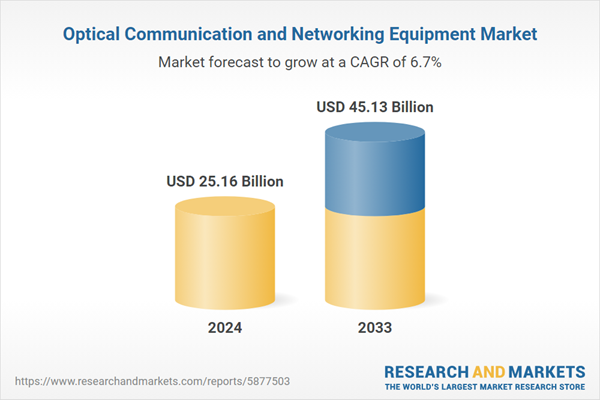Optical communication and networking equipment utilize light signals to transmit data, providing high-speed and reliable communication. The equipment consists of various components, including optical transmitters, receivers, fibers, and amplifiers. Optical transmitters use lasers to generate light pulses, encoding data into them. These pulses are then transmitted through optical fibers, which are made of a high-quality, transparent material such as glass or plastic. The light signals travel through these fibers with minimal loss and distortion, allowing data to be transmitted over vast distances. Optical receivers at the receiving end detect the light pulses and convert them back into electrical signals for further processing. Further, optical amplifiers are used to amplify the light signals periodically along the fiber to ensure signal integrity and reach longer distances. One of the significant advantages of optical communication and networking equipment is its high bandwidth capability. Unlike traditional copper-based communication, optical fibers can carry a vast amount of data simultaneously, allowing for faster and more efficient transmission. Additionally, optical signals are immune to electromagnetic interference, providing a secure and reliable communication channel. Currently, there are different types of product variants available, including single- and multi-mode fibers.
Optical Communication and Networking Equipment Market Trends:
The global optical communication and networking equipment market is influenced by the increasing demand for high-speed data transmission and bandwidth-intensive applications and the rapid expansion of cloud computing, data centers, and the Internet of Things (IoT). Moreover, the proliferation of smartphones and mobile devices, coupled with the growing popularity of video streaming and online gaming, are supporting the market growth. In line with this, advancements in technology, such as the deployment of 5G networks and the emergence of internet protocol (IP) traffic, and the rising trend of virtualization and software-defined networking (SDN) are creating a positive outlook for the market. Furthermore, increasing investments in research and development (R&D) activities to enhance the efficiency and performance of optical communication technologies and the growing adoption of fiber-optic cables over traditional copper cables are propelling the market growth. Additionally, the surging demand for high-definition video content, online gaming, and video conferencing applications and the implementation of government initiatives and policies promoting digitalization and connectivity across regions are contributing to the market growth. Other factors, such as the rising awareness about the benefits of optical communication solutions, including reduced power consumption, increased data security, and improved network flexibility, and the presence of major market players investing in strategic collaborations, are strengthening the market growth.Key Market Segmentation:
The publisher provides an analysis of the key trends in each segment of the global optical communication and networking equipment market, along with forecasts at the global, regional, and country levels from 2025-2033. Our report has categorized the market based on component, technology, and industry vertical.Component Insights:
- Optical Fiber
- Transceiver
- Switch
- Others
Technology Insights
- Synchronous Optical Network (SONET)
- Wavelength Division Multiplexing (WDM)
- Fiber Channel
Industry Vertical Insights:
- IT and Telecom
- BFSI
- Military Defense
- Oil and Gas
- Medical and Healthcare
Regional Insights:
- North America
- United States
- Canada
- Asia Pacific
- China
- Japan
- India
- South Korea
- Australia
- Indonesia
- Others
- Europe
- Germany
- France
- United Kingdom
- Italy
- Spain
- Russia
- Others
- Latin America
- Brazil
- Mexico
- Others
- Middle East and Africa
Competitive Landscape:
The report has also provided a comprehensive analysis of the competitive landscape in the global optical communication and networking equipment market. Detailed profiles of all major companies have been provided. Some of the companies covered include Adtran Inc., Arista Networks Inc., Broadcom Inc., Ciena Corporation, Cisco System Inc., Fujitsu Limited, Huawei Technologies Co. Ltd., II-VI Incorporated, Infinera Corporation, Juniper Networks Inc., NEC Corporation, Nokia Corporation, Telefonaktiebolaget LM Ericsson, etc. Kindly note that this only represents a partial list of companies, and the complete list has been provided in the report.Key Questions Answered in This Report:
- How has the global optical communication and networking equipment market performed so far, and how will it perform in the coming years?
- What are the drivers, restraints, and opportunities in the global optical communication and networking equipment market?
- What is the impact of each driver, restraint, and opportunity on the global optical communication and networking equipment market?
- What are the key regional markets?
- Which countries represent the most attractive optical communication and networking equipment market?
- What is the breakup of the market based on component?
- Which is the most attractive component in the optical communication and networking equipment market?
- What is the breakup of the market based on technology?
- Which is the most attractive technology in the optical communication and networking equipment market?
- What is the breakup of the market based on industry vertical?
- Which is the most attractive industry vertical in the optical communication and networking equipment market?
- What is the competitive structure of the global optical communication and networking equipment market?
- Who are the key players/companies in the global optical communication and networking equipment market?
Table of Contents
Companies Mentioned
- Adtran Inc.
- Arista Networks Inc.
- Broadcom Inc.
- Ciena Corporation
- Cisco System Inc.
- Fujitsu Limited
- Huawei Technologies Co. Ltd.
- II-VI Incorporated
- Infinera Corporation
- Juniper Networks Inc.
- NEC Corporation
- Nokia Corporation
- Telefonaktiebolaget LM Ericsson
Table Information
| Report Attribute | Details |
|---|---|
| No. of Pages | 135 |
| Published | March 2025 |
| Forecast Period | 2024 - 2033 |
| Estimated Market Value ( USD | $ 25.16 Billion |
| Forecasted Market Value ( USD | $ 45.13 Billion |
| Compound Annual Growth Rate | 6.7% |
| Regions Covered | Global |
| No. of Companies Mentioned | 13 |









